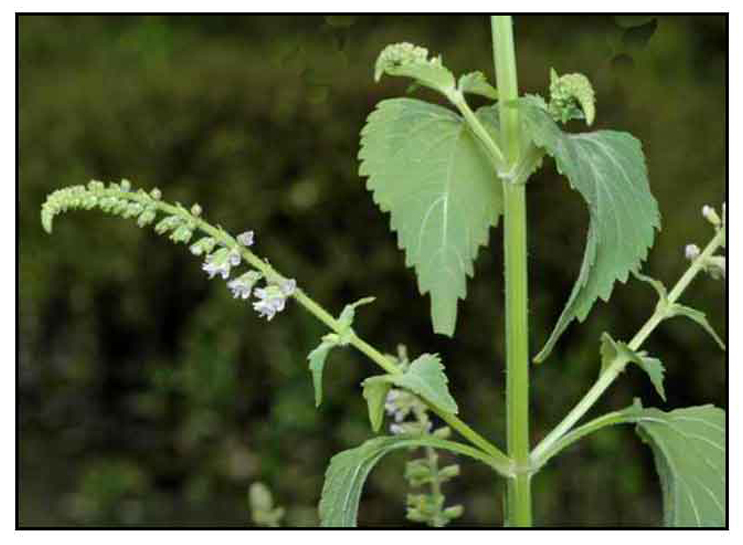 Botany Botany
Loktokong is an erect, much-branched, nearly smooth herb, 40 to 90 centimeters high. Stems are prominently 4-angled. Leaves are long-stalked, thin, ovate to oblong-ovate, 2 to 6 centimeters long, glandular and hairy on both upper and lower surfaces, with both ends pointed and with toothed margins. Flowers are lilac or pink, about 2.5 millimeters long, numerous, crowded, and borne in racemes 3 to 10 centimeters long and 5 to 6 millimeters in diameter. Calyx, in fruit, is spreading or somewhat reflexed, 3 to 3.5 millimeters long.
Distribution
- An introduced weed.
-
In open, waste places, usually wet or damp soil, and widely scattered in settled areas in the Ilocos Norte, Pampanga, Rizal, Bataan, Laguna, and Quezon Provinces in Luzon; and in Mindanao (Cotobato).
- Also occurs in tropical Africa and Asia, through Malaya to tropical Australia.
Constituents
- Leaves and flowers yield an essential an essential oil with main components of ethyl-eugenol (39%), methyl-isoeugenol (8%), limonene (7%), 1,8-cineole (eucalyptol, 5%), ß-elemene (5%), ß-caryophyllene (5%), ß-selinene (4%), citronellal (3.5%), geranyl acetate (2.9%), a-humulene (2.4%), isobornyl acetate (2%) and d-cadinene (2%).
- Yields alkaloids, phenols, flavonoids, triterpenes, coumarins, saponins, and sterols. (see study below) (11)
- Phytochemical screening of petroleum ether extract of leaves yielded phytosterols; an alcohol extract yielded alkaloids, carbohydrates, glycosides, and phytosterols; water extract yielded alkaloids, carbohydrates glycosides, volatile oils, gums, and mucilage; and an acetone extract yielded alkaloids and phytosterols. (12)
- GC-MS study for volatile oil yielded 64
constituents with main components of sesquiterpenoids and monoterpene. (see study below) (14)
Properties
- Aromatic; belongs to the mint family, and closely allied to coleus and basil.
- Repellent, mosquitocidal.
- Studies have shown mosquitocidal, repellent, antimicrobial, anticonvulsant, cytotoxic, antioxidant properties.
Caution
- Oral consumption of leaves as decoction or infusion reported to cause mouth ulcers.
- Eugenol is toxic in large amounts and can cause contact dermatitis.
Uses
Edibility
- Leaves used to flavor food.
- Leaves used as tea.
- Caution: Reported to cause oral ulcers.
Folkloric
- In Java, crushed leaves used as sedative; also, applied to sprains.
- Externally, decoction used as lotion.
- Decoctions used for epilepsy, heart palpitations, neuralgia and convulsions.
- Infusion of fruit taken for parturition in case of delayed birth. (Prosea) (10)
- Leaf sap squeezed into nostrils of children to induce sneezing to cure headaches. (Prosea) (10)
- In Cameroon, leaves used for infectious diseases and gastroenteritis.
Others
- Repellent: Burning of plant used to repel mosquitoes and snakes.
Studies
• Mosquitocidal / Ovicidal: Study of leaf extract against C quinquefasciatus showed 100% egg mortality at 100 ml/L. (1)
• Mosquitocidal / Octasane Mosquitocidal compound, octasane, isolated from the leaves of M. polystachyum exhibited larvicidal activity with LC50 value of 7.2 mg/I against Culex quinquefasciatus. (2)
• Volatile Oils / Repellency: Volatile oils from leaves of two plants – Moschosma polystachyum and Solanum xanthocarpum were effective as repellents with more than 300 minutes of protection against the bite of Cx quinquefasciatus. Both showed no adverse effects on human volunteers and can be applied as protection against mosquito bites. (3)
• Antimicrobial / Leaves: Phenolic extract of leaves was tested for in vitro antimicrobial activity against five bacteria (E Coli, P aeruginosa, S aureus, B subtilis, M luteus) and three fungi (F oxysporum, A niger, H oryzae). Acidic extract showed high activity against Gram-positive bacteria. Among the fungi, maximum activity was exhibited against Aspergillus niger. The antimicrobial activity might to attributed to high levels of polyphenolic compounds, caffeic acid, and rosmarinic acid. Results showed a promise for ethnopharmacological use as a broad-spectrum antimicrobial. (5)
• Anticonvulsant: Alcohol and aqueous extracts of leaves showed significant antiepileptic activity in both MES-induced and PTZ convulsion models. (7)
• Antibiotic Potentiation Against MDR Gram-Negative Bacteria: Study evaluated methanol extracts of four Cameroonian dietary plants for ability to improve activity of commonly used antibiotics against MDR Gram-negative bacteria expressing active efflux pumps. The MIC of the studied extracts ranged from 256-1024 µg/ml. Basilicum polystachyon recorded the lowest MIC value (256 µg/ml) against E. aerogenes and P. stuartii. The extracts showed synergistic effects (FIC≤0.5) against the studied bacteria, with an average 75.3% of tested antibiotics. (11)
• Antibiotic Potentiation / Synergistic Effects: Study evaluated four Cameroonian dietary plants (Basilicum polystachyon, C. frutescens, Brassica. oleracea var. italica and B. oleracea var butyris) for potentiating activity of commonly used antibiotics against MDR gram-negative bacteria expressing active efflux pumps. All the plants yielded alkaloids, phenols, flavonoids triterpeneds, and sterols. Basilicum polystachyon recorded the lower MIC value (256 µg/ml) against E. aerogenes ATCC 13048 and P. stuartii ATCC 29916. The extracts showed synergistic effects against studied bacteria. (13)
• Volatile Oil / Bioactivity: Study of volatile oil for bioactivity showed antimicrobial (inhibitory effect on 8 plant pathogenic fungi), antioxidant (scavenging of DPPH free radicals), and cytotoxic effects.(see constituents above) (14)
Availability
Wild-crafted.
|

![]()



 Botany
Botany